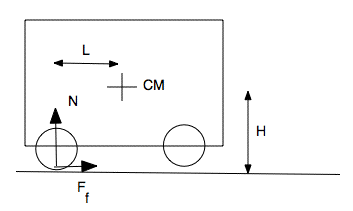
 |
|
|
Wheelstands or 'wheelies'In Wheelstands or 'wheelies', if there is sufficient torque, the front wheels of a front wheels of a rear-drive car or bike can lift off the ground during forwards acceleration. What are the conditions of torque, friction, centre of mass and geometry under which they happen? In a very similar problem, we consider whether it is possible for a cyclist to brake so hard with the front wheel that s/he can rotate about the front axle and travel over the handlebars. In both cases, I urge readers not to try either of these experimentally, for obvious reasons. (And we can argue that, if I put some analysis and video here, it ought to make it less likely that readers will go and investigate experimentally.)
In the sketch, a vehicle accelerates towards the right. The centre of mass (CM) is a distance L ahead of the rear wheels, and a height H above the horizontal road. The front wheels have just left contact with the road, because the vehicle has rotated a little, but with negligible angular acceleration. The rear wheels are driven, so the contact force exerted on them by the road may be decomposed into a normal component N and a frictional component Ff, shown by the vector arrows. (For a revision, see Weight and Contact Forces.) 
Consider rotation and torques acting about the centre of mass. (Why this point? See below*.) In the counter-clockwise direction, the friction exerts a positive torque HFf and the normal force a torque − LN. If the angular acceleration is negligible, as assumed, then these add to zero, so
Force and torque condition. The rear wheels must be capable of supplying a force of mgL/H. For a typical car, L is greater than H. For a bicycle, however, it could be less. However, it is of order unity, so the horizontal force supplied by the wheels must be comparable with the weight of the vehicle. The required torque, on a wheel with radius r, is of course τ = rFf = rmgL/H. With this force (or torque), the vehicle would accelerate forwards at Ff/m, so the wheelie would be produced during a forwards acceleration of gL/H. Friction condition. An upper bound to the friction force Ff is imposed by limiting friction. With a coefficient of static friction μs, friction satisifies
The coefficient of static friction μs is typically about 1, but could be as high as say 1.2 for a clean dry road. As mentioned above, for a typical car, L is greater than H, so such a (rear-drive) car would skid the rear wheels before the front wheels lifted off. For motor cycles (and some bicycles), however, L/H could be rather less than one. In the photo shown below, this ratio is no more than 1/5. So, with sufficient torque available by using low gears, the front wheel can be lifted off rather easily. Slope. On a hill with slope θ, the torque exerted by the normal force is reduced by a factor cos θ, and the normal force is also less than mg. So it is easier to do a wheelie on a steep slope. The effect is not large on a road on public roads, because slopes are rarely more than several degrees, so the cos term is very close to unity. For a 10% slope, θ = 5.7° and cos θ = 0.995. For a 20% slope, θ = 11.5° and cos θ = 0.98. Using a low gear on my bicycle to pedal up library hill at UNSW, I've accidentally lifted the front wheel. In the photo at right, I did it briefly and deliberately. (Warning: lifting a wheel is dangerous. Library hill is not a public road, and the slope is about 17% – much greater than a normal road, and it feels greater still.) Here, the wheel lifting is not directly due to the cos θ term, but rather a sin θ term: because the road is steep, I am pedalling hard, so Ff is large. It's quite easy to this. I live in a very hilly area, and so have a very low gear of my bike: the smallest front sprocket and the largest back sprocket have the same diameter. Using this gear, the torque applied at the back wheel equals that appled by the pedals. (For normal gear ratios, where the rear sprocket is small, the torque on the wheel is rather less.) Now the radius r of the wheel is greater than the length R of the pedal crank so, in this low gear, the force applied to the ground by the tires is less than that applied at the pedals by a factor R/r, which is about 1/2. Standing on the pedals, one can exert a force of order mg, but it can be greater than this if one pulls up on the handle bars. So, in normal riding, Ff is rather less than mg/2. However, looking at this photo, we see that L/H is much less than 1/2, so it's quite relatively easy to lift the front wheel. Hard braking
In an extreme stop, for the rear wheels just to lift off, this time we have
While this is unlikely to be satisified for a car, it is possible for a bicycle, particularly if the cyclist is leaning forwards over the handlebars, which makes L' small.
See also Car Physics |
|
||||||||